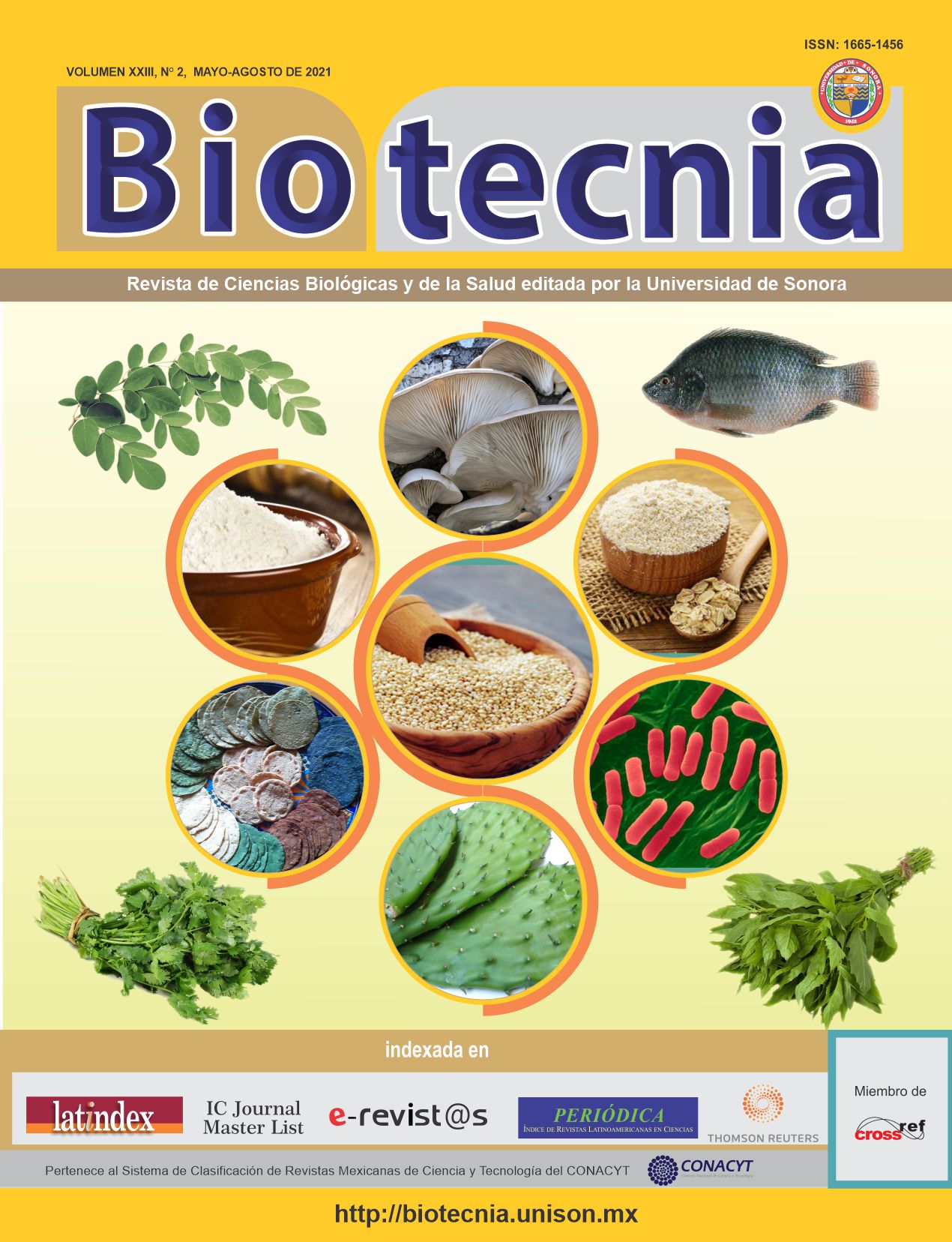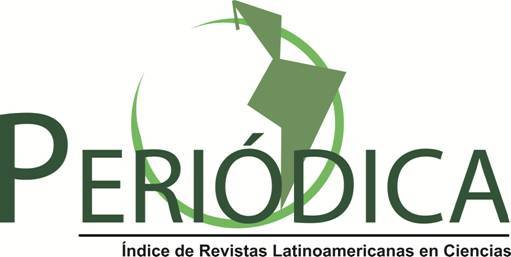Prediction of the thermal resistance of Escherichia coli O157:H7 in ground beef as a function of temperature, carvacrol and fat concentrations
DOI:
https://doi.org/10.18633/biotecnia.v23i2.1372Keywords:
thermal resistance, natural antimicrobials, meat safety, response surface methodologyAbstract
Escherichia coli O157: H7 is one of the most important pathogens in ground beef, and the risk of contamination compromises its safety and quality. Thermal treatments are the main option to ensure food safety; although, the use of additional barriers such as the addition of antimicrobial agents increases safety margins against pathogens growth. In this work the effects and interactions of temperature (55-65 °C), carvacrol (0-2%) and fat (5-20%) on thermal resistance (D-value) of E. coli O157: H7 in ground beef were evaluated using response surface methodology. Temperature was the main factor of inactivation, while fat exhibited a protective effect over the pathogen survival. There was an interaction effect between fat and carvacrol, at high concentrations of fat the carvacrol favored the inactivation of the pathogen. The optimal combination of fat, carvacrol and temperatura that ensure the highest inactivation of the pathogen was 63°C, 11% fat and 1.6% carvacrol. The obtained model allow to predict the thermal resistance of E. coli O157: H7 in any combination of temperature, carvacrol and fat, within the limits studied.
Downloads
References
Ahmed, N. M., Conner, D. E., Huffman, D. L. 1995. Heat‐resistance of Escherichia coli O157: H7 in meat and poultry as affected by product composition. Journal of Food Science. 60: 606- 610.
Ait‐Ouazzou, A., Espina, L., Gelaw, T., de Lamo‐Castellvi, S., Pagan, R., García‐Gonzalo, D. 2013. New insights in mechanisms of bacterial inactivation by carvacrol. Journal of Applied Microbiology. 114: 173-185.
Baluja, S., Kulshrestha, A., Movalia, J. 2017. 1-Octanol-water partition coefficient of some cyanopyridine and chalcone compounds. Revista Colombiana de Ciencias Quimico- Farmaceuticas. 46: 342-356.
Baranyi, J., Roberts, T. A. 1995. Mathematics of predictive food microbiology. International Journal of Food Microbiology. 26: 199-218.
Can Baser, K. 2008. Biological and pharmacological activities of carvacrol and carvacrol bearing essential oils. Current Pharmaceutical Design. 14: 3106-3119.
Cashman, K. D., Hayes, A. 2017. Red meat’s role in addressing ‘nutrients of public health concern’. Meat Science. 132: 196- 203.
Centers for Disease Control and Prevention. 2020. E. coli (Escherichia coli). Disponible en: https://www.cdc.gov/ecoli/index.html
Grompone, M. A. 1991. Propiedades fisicas y quimicas de las grasas bovinas fraccionadas e interesterificadas. Grasas y Aceites, 42: 349-355.
Juneja, V. K., Eblen, B., Marks, H. 2001. Modeling non-linear survival curves to calculate termal inactivation of Salmonella in poultry of different fat levels. International Journal of Food Microbiology. 70: 37-51.
Juneja, V. K., Friedman, M. 2008. Carvacrol and cinnamaldehyde facilitate thermal destruction of Escherichia coli O157: H7 in raw ground beef. Journal of Food Protection. 71: 1604-1611.
Juneja, V. K., Novak, J. S. 2003. Heat resistance of Escherichia coli O157: H7 in cook‐in‐bag ground beef as affected by pH and acidulant. International Journal of Food Science & Technology. 38: 297-304.
Juneja, V. K., Thippareddi, H., Friedman, M. 2006. Control of Clostridium perfringens in cooked ground beef by carvacrol, cinnamaldehyde, thymol, or oregano oil during chilling. Journal of Food Protection. 69: 1546-1551.
Juneja, V. K., Yadav, A. S., Hwang, C.-A., Sheen, S., Mukhopadhyay, S., Friedman, M. 2012. Kinetics of thermal destruction of Salmonella in ground chicken containing transcinnamaldehyde and carvacrol. Journal of Food Protection. 75: 289-296.
Kim, J.-S., Lee, M.-S., Kim, J. H. 2020. Recent Updates on Outbreaks of Shiga Toxin-Producing Escherichia coli and Its Potential Reservoirs. Frontiers in Cellular and Infection Microbiology.10: 1-10.
Lin, C.-T. J. 2018. Self-reported methods used to judge when a hamburger is ready at-home in a sample of US adults. Food Control. 91: 181-184.
Lyon, B., Berry, B., Soderberg, D., Clinch, N. 2000. Visual color and doneness indicators and the incidence of premature Brown color in beef patties cooked to four end point temperatures. Journal of Food Protection. 63: 1389-1398.
Mongomery, C. D. 2013. Design and analysis of experiments (eighth ed.): John Wiley & Sons Inc.
Nazzaro, F., Fratianni, F., De Martino, L., Coppola, R., De Feo, V. 2013. Effect of essential oils on pathogenic bacteria. Pharmaceuticals. 6: 1451-1474.
Rios-Flores, J. A. y Castillo-Arce, M. L. 2015. La competitividad de la carne fresca de res mexicana en el mercado estadounidense. Estudios Fronterizos, 16: 221- 245.
Scandorieiro, S., de Camargo, L. C., Lancheros, C. A., Yamada-Ogatta, S. F., Nakamura, C. V., de Oliveira, A. G., Andrade, C. G., Duran, N., Nakazato, G., Kobayashi, R. K. 2016. Synergistic and additive effect of oregano essential oil and biological silver nanoparticles against multidrug-resistant bacterial strains. Frontiers in Microbiology. 7: 1-14.
Smith, S., Maurer, J., Orta‐Ramirez, A., Ryser, E., Smith, D. 2001. Thermal inactivation of Salmonella spp., Salmonella typhimurium DT104, and Escherichia coli 0157: H7 in ground beef. Journal of Food Science. 66: 1164-1168.
Surendran Nair, M., Lau, P., Belskie, K., Fancher, S., Chen, C.-H., Karumathil, D. P., Yin, H.-B., Liu, Y., Ma, F., Upadhyaya, I. 2016. Potentiating the heat inactivation of Escherichia coli O157: H7 in ground beef patties by natural antimicrobials. Frontiers in Microbiology. 7: 1-8.
USDA-FSIS. (2020). U.S. Department of Agriculture, Food Safety Inspection Service. Disponible en: https://www.fsis.usda.gov/wps/portal/fsis/topics/food-safety-education/getanswers/foodsafety-fact-sheets/meat-preparation/color-ofcooked-ground-beef-as-itrelates-to-doneness
Downloads
Published
How to Cite
Issue
Section
License
Copyright (c) 2021

This work is licensed under a Creative Commons Attribution-NonCommercial-ShareAlike 4.0 International License.
The journal Biotecnia is licensed under the Attribution-NonCommercial-ShareAlike 4.0 International (CC BY-NC-SA 4.0) license.





_(1)_(1).png)






_(2).jpg)





